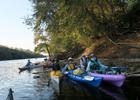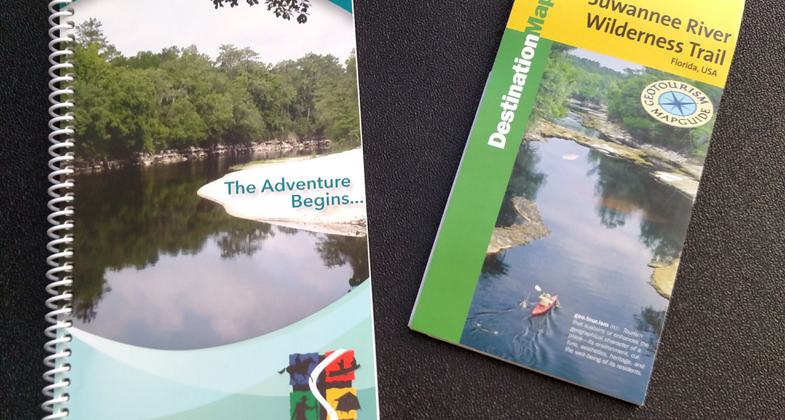Suwannee River Wilderness Trail
check with the trail manager for updated details before visiting.
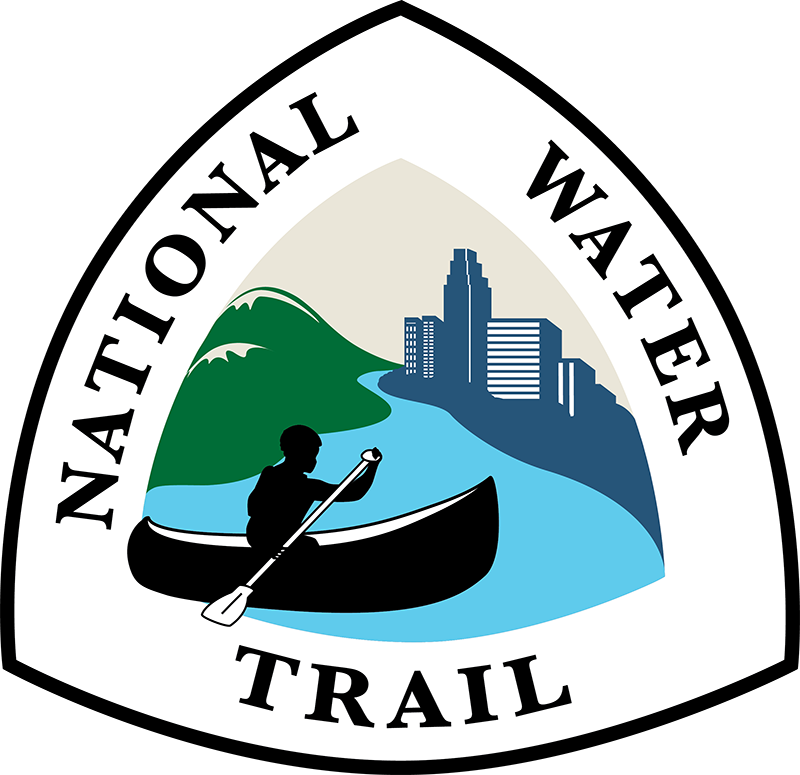
Suwannee River Wilderness Trail
State
National Water Trail
- Length
235 miles
- Elevation Gain
--
- Route Type
out & back
(1 review)
- Length
235 miles - Elevation Gain
-- - Route Type
out & back
The majestic Suwannee River begins just below the Okefenokee National Wildlife Refuge in southeast Georgia, anchored by pristine National Wildlife Refuges on either end of the 235-mile meandering waterway. It coils through the heart of north central Florida, ending in the Lower Suwannee National Wildlife Refuge on the Gulf Coast. Steeped in rich culture and history, this beloved river remains a wild natural wonder with endless delights for adventurous explorers.
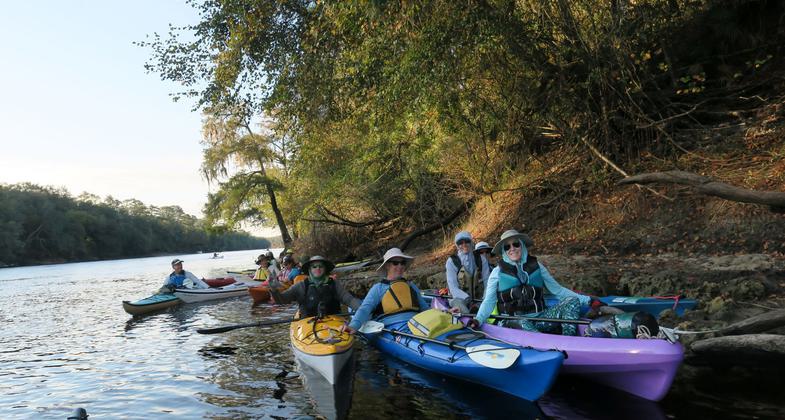
Paddlers along the Suwannee River Wilderness Trail. Photo by Doug Alderson. Photo by Doug Alderson, Office of Greenways and Trails
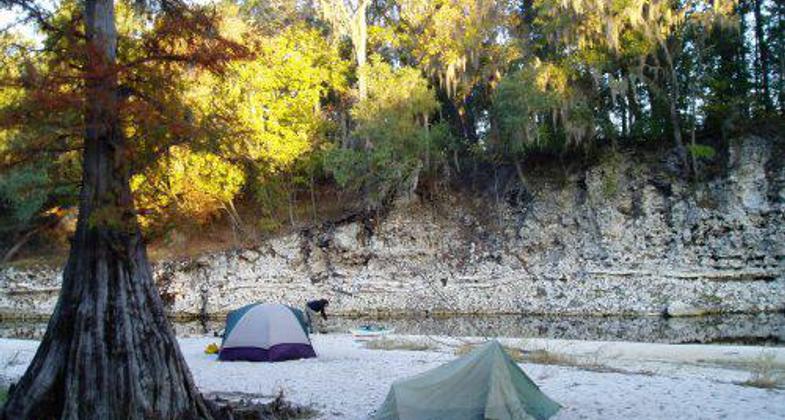
Sandbar camping on the Suwannee River

Sunrise on the Suwannee, Doug Alderson credit

Hundreds of volunteers join non-profit organization Current Problems to clean up tons of garbage during annual cleanup events along the river

Several websites and excellent downloadable map guides are available describing public access, accommodations, safety guidelines including float plans, universal accessibility, natural/cultural/historical resources, and links to other recreation opportuni
Location: The river emerges from the Okefenokee Swamp in southeast Georgia, and winds 235-miles to the Gulf of Mexico.
- States: Florida, Georgia
- Counties: Charlton, Clinch, Columbia, Hamilton, Lafayette, Suwannee, Madison, Levy, Dixie, Gilchrist
- Cities/Townships: Fargo, White Springs, Branford, Fanning Springs, the town of Suwannee
Steeped in rich culture and history, the majestic Suwannee River remains a wild, natural wonder with endless delights for adventurous explorers. It is anchored by a pair of pristine National Wildlife Refuges on either end of its 235 meandering miles and is enfolded by large tracts of public conservation lands. Beginning just below the Okefenokee National Wildlife Refuge in southeast Georgia, the Suwannee connects with the popular Okefenokee Wilderness Canoe Trails, designated as a National Water Trail and part of the National Wilderness Preservation System. The river emerges as a small flow at Georgia's Stephen C. Foster State Park, the primary entrance to the legendary Okefenokee Swamp. Moss-draped trees reflect in the black swamp waters where gnarled cypress knees pierce the glass-like surface, offering adventurous paddlers and photographers stunning scenery. The river rolls past the Suwannee River Visitor Center in Fargo, Georgia, and near the Suwannee River Eco Lodge, flowing through an unspoiled watershed about thirty miles to the Florida state line.
In Florida, the original endpoints of the 170-mile state-designated Suwannee River Wilderness Trail (SRWT) begin at the town of High Springs near the Stephen Foster Folk Culture Center State Park. The river coils through the heart of north central Florida, ending in the Lower Suwannee National Wildlife Refuge on the Gulf of Mexico. In seeking the National Water Trail designation, the Office of Greenways & Trails proposes to extend the length of the river about 65 miles upstream to include its origins within the Okefenokee National Wildlife Refuge and Stephen C. Foster State Park in Southeast Georgia. This would make the proposed National Water Trail designation a total distance of 235 miles and provide connectivity with the Okefenokee National Water Trail.
The character and scenery of the river corridor change immensely as it meanders to the Gulf, including a surprising stretch of Class III rapids at Big Shoals State Park. A well-loved hiking opportunity, the 1,300-mile Florida National Scenic Trail hugs the river's shady banks for about 41 miles. Off-road biking draws cyclists to explore miles of enticing trails developed by the Suwannee River Water Management District (SRWMD)and the Suwannee Bike Association. Equestrians have many appealing destinations in the Suwannee River Basin. The Suwannee River Greenway and 32-mile National Recreation Trail, the Nature Coast State Trail, offer multi-use paved trails for residents and visitors alike. Drawing people for millennia to enjoy cool, clear water is 196 springs in the Suwannee Basin. Many spill crystal clear waters into the dark, tannic river and are delightful to visit on a hot summer day.
Established in 2002, the state-designated SRWT begins at Stephen Foster Folk Cultural Center State Park in White Springs. The SRWT is managed by Florida State Parks whose mission is to provide resource-based recreation while preserving, interpreting, and restoring natural and cultural resources. The planning and implementation of the SRWT involved years of meetings between public and private partners in eight riparian counties along the original 170-mile trail in Florida. In 2004, the National Association of Recreation Resource Planners presented the Excellence in Planning Award to the SRWT, in recognition of planning excellence for a multi-jurisdictional cooperative effort, including the formation of public-private partnerships, to create a seamless park experience along the Suwannee River in North Central Florida.
The SRWT is a partnership of private and public land managers along the Suwannee River who have coordinated efforts to enhance paddling and exploration of the river. A series of recreation hubs and river camps offer a wide range of accommodations about a day's paddle apart. With hot showers, restrooms, and screened platforms, each river camp is sited to close gaps of more than 10 miles between established parks and campgrounds on the river, making a safe distance for a day of paddling. Innovative design planning went into the construction of these river camps to mitigate flooding impacts. Volunteer camp hosts based at river camps help to maintain the facilities, report visitation to the park office, greet guests and notify park staff of any problems.
There is a wealth of educational opportunities along the SRWT. Most of the rivers nine state parks and two national wildlife refuges in Florida and Georgia offer educational programs on a wide range of topics. Various public partners provide options ranging from virtual tours, mobile apps, and interactive maps to riverside kiosks with interpretive information.
In Georgia, stargazers appreciate the particularly dark sky at the Stephen C. Foster State Park where astronomy programs share an 18-inch telescope. Park rangers also lead sunset boat and kayak tours in the beautiful Okefenokee Swamp to share ecology, history, and wildlife. The Okefenokee National Wildlife Refuge has a compelling array of technology including Discover Oke a new mobile phone app with a place-based scavenger hunt-style trivia game and wildlife spotting tool. It gives smartphone users an exciting new way to learn about and appreciate the refuge's extraordinary flora and fauna.
At the Suwannee River Visitor Center in Fargo, visitors learn not only about the Okefenokee Swamp's ecosystem but also how buildings can be made from recycled car parts. The center mixes environmental education with engineering showmanship. A third of the building materials were made from recycled content, including a retaining wall made from old dashboards and electrical cables.
In Florida, there is a wide variety of educational opportunities from hands-on experiences to online virtual tours. Prospects range from forging horseshoes at the Craft Square in Stephen Foster Folk Culture Center State Park in Florida to virtually exploring or diving the City of Hawkinsville Underwater Archeological Preserve, a wreck site of one of the last steamships. Partner sites share everything from the history of Native Americans, the Civil War, and early Florida settlement, to exploring the watershed's abundant natural resources; karst formation, springs, diverse ecosystems, sturgeon, manatee, and much more.
Some educational initiatives are regional in scope like the Great Florida Birding & Wildlife Trail (GFBT) which promotes wildlife viewing destinations at multiple locations along the river. The GFBT sponsors community events and offers Wings Over Florida and Junior Birder Program that encourage the public to become ethical wildlife viewers.
Many youth groups utilize the SRWT, some as a challenging program for troubled youth. Eckerd Youth Alternatives and the Gator Wilderness Camp School focus their efforts on children who need some redirection down a better path. The Military Trails Camp Program brings children from diverse communities all over the country whose parents have been deployed in the military.
The well-loved river enjoys community support through many non-profit programs including Current Problems, a non-profit volunteer group that has coordinated with many other groups to hold Adopt a River, Restore a Shore, and Plant A Pond events for fifteen years. One of this organization's largest ongoing projects is the Great Suwannee River Basin Cleanup, which occurs from September through November each year. Since the project's launch in 2010, 2,023 volunteers have contributed 8,132 hours of their time to remove 94,490 pounds of trash from the Suwannee River from the Georgia state line to the Gulf of Mexico. Many of those volunteers are folks who live along the river and people who enjoy boating, paddling, and fishing on the Suwannee, as well as swimming, snorkeling, and diving in its many beautiful springs. The annual cleanup efforts of these volunteers speak to their commitment to preserving this iconic waterway.
The majestic Suwannee River is an ideal destination for Florida visitors and residents alike to explore rich history and culture through endless adventures in a natural, unspoiled landscape.
Accessibility Information
No text provided.
Reviews
Tia R
Great Review
We paddled the stretch of the Suwannee from White Springs to Branford in early March. It was fabulous! Spring wildflowers, azaleas and plums blooming along the banks. Top that off with 5 wonderful river camps along the way, each with screened sleeping platforms, large picnic pavilion, electricity, and bathhouses with flush toilets with hot showers! And the stays are free. We called this our luxury cruise!
Allowed Uses:
Boating, motorized Boating, human-powered SwimmingOther Activities
- Camping
- Fishing
- Heritage and history
- Hunting
- Wildlife viewing / observation
Public Contact
Amy ConyersDepartment of Environmental Protection
Lafayette Blue Springs State Park
Mayo, FL 32066
[email protected] • 386-294-3667
More Details
- Elevation (low): --
- Elevation (high): --
- Elevation (cumulative): --
- Part of a Trail System? No
- State Designations: Florida State Paddling Trail
- Surface (primary): --
- Surfaces (additional): Rock, boulders
- Tread Width (average): 0"
- Tread Width (minimum): 0
- Running length (minimum): --
- Tread Grade (average, percent): --
- Tread Grade (maximum):
- Running length (maximum): --
- Cross-slope (average, percent): 0
- Cross-slope (maximum): --
- Running length (maximum): --
- Certified as an NRT
Oct 25, 2020

